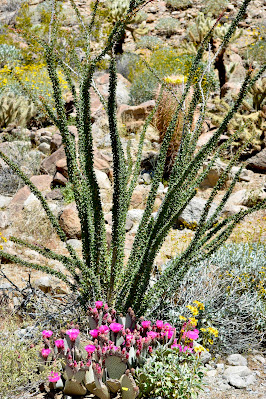Fun camping adventure in the Anza-Borrego Desert State Park in southern California to see the explosion of color. Happy Spring!
This site celebrates living a simple lifestyle. It is about learning to live a craftsman way of life - where simplicity, handmade, community and learning are at the root of a wealthy journey.
Sunday, April 7, 2024
Wednesday, April 3, 2024
Getting Native Plants Established
plants. There were multiple driving factors for this effort. First, I enjoy being able to identify plants and understand where and how they survive and flourish in their native landscape. Being new to California, I knew very little about the native plants of the area and especially those that are local to the southern California region. The second primary driver was water conservation. I have no interest in heavy irrigation required to grow most non-natives in this region. And finally, when we bought this property many of the plants were prone to repeat bug infestations. I knew from past experience that native plants are naturally much less prone to invasive insect infestations.
I am happy to write that our efforts are continuing to pay off and meet our goals. Gone are the white flies and aphids. We can now spot and name many native plants of California in their native landscapes. Gone is the constant need for watering and irrigation! We are shocked how little water the garden uses now. My biggest regret with the mostly-native landscaping effort is all the time and effort we invested to install an irrigation system. I did countless hours reading and researching to try to determine how much irrigation was necessary. There is much conflicting information out there, and little that guides on just what to do for urban native-plant landscapes. But, in the end I discovered that the real answer is next to no supplemental water is required. Once the native plants became established in our yard, they required little to no supplemental water beyond what nature provides.
Getting the plants established is absolutely key. Our experience is that it has everything to do with the time of planting. When we planted in the December through February timeframe then the plants needed negligible water and survived the spring-summer-fall dry season with little to no additional water. When we planted in the March through November timeframe, we found ourselves having to water much more with a higher likelihood of plant loss. It all comes down to planting and letting them get established during the winter rainy season.
The good news is that our irrigation zones in the native plant areas are completely shut off year-round now. The bad news is that we invested much time, money and effort to install all this infrastructure. If I had it all to do over again I would skip installing irrigation in the native plant areas. In the non-native areas, such as our vegetable garden, the drip/emitter water system works well and minimizes hand watering.
Conclusion: If you are planting native plants,then strongly consider skipping the installation of irrigation in these areas. For a higher rate of native plant growth and development, then plant in the winter months.
Happy gardening!












